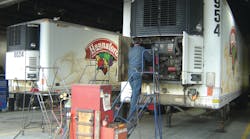Are you hindering technicians from making informed decisions?
The first computerized maintenance management system (CMMS) that I am aware of was developed by Mobil Oil in 1965. It ran on the most sophisticated machine at the time – the IBM 360 mainframe.
This CMMS was designed to help you remember to change the oil in your forklifts and mobile equipment. It operated on a punch card system called Midec.
Until the mid-1970s, most computer access was via punched cards. Programs and data were punched by hand on a key punch machine and read into a card reader.
In 1968, with a grant from Union 76, the American Trucking Associations (ATA) convened a work group to define all the repairs, codes, conditions, failure modes and repair locations for mobile equipment. This effort grew into the ATA’s VMRS (Vehicle Maintenance Reporting Standards), which is still in use today.
Updated yearly, VMRS sets the standard for communicating maintenance information within a service organization.
Timeshare and Service Bureaus
One of the models that became very popular with the mobile maintenance community was timeshare and service bureaus. With timeshare, you could “share” one of the mainframe computers and run your program when the computer was otherwise idle.
Service bureaus were another variant on sharing the behemoth computers. The service bureau processed your data in a batch (called batch processing) and generated your reports. The premier service bureau of this period was called Mainstem.
Mainstem had a unique value proposition. It processed your data into reports. Think of the old ADP and how you mailed in the payroll information and ADP mailed the checks back.
Mainstem provided an additional service. Your data was reviewed by a maintenance specialist. This group of specialists added significant value since they looked at maintenance data day in and day out and made specific recommendations for improvement. They were all old-time maintenance managers and had, as they saying goes: “been there and done that.”
Lack of Specialists
Zoom forward in time 40 years. Today, we have a wealth of powerful computing systems and, last time we looked, there were more than 200 vendors.
We also now have a dearth of people like the Mainstem maintenance specialists. Most of us don’t have knowledgeable people looking over our shoulders giving us the advantage of their wisdom.
Today’s systems are extraordinarily powerful and may one day express an informed opinion about the data we enter.
Until that day, we are literally going to have to grow the capability. We have to find those wise eyes in our organizations and capture step-by-step what they do and exactly what they are looking for.
We need to take these procedures (which I call protocols) and pass them down to the next generation and to the shop floor. We want our technicians, those who are making hundreds of business decisions, to start making judgments based on data and experience rather than just experience.
Every time a technician opens a machine, they are making business decisions – like repair/replace, replace/rebuild, how far to go into a problem, repair the symptom or cause, temporary repair, extremely temporary repair to last until Saturday, use will-fit or OEM parts, etc.
How do you expect your people to make great decisions if you hid the data or make it too much trouble to collect?
If you have to, lock your most experienced maintenance people in a room until they tell you their secrets. Learn what capabilities they use with your CMMS, the reports they generate, the data focus on and how they determine their appropriate actions.
Get this wisdom before it is too late.




